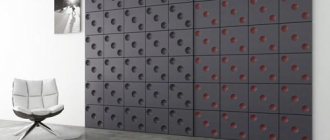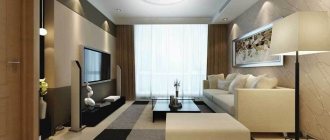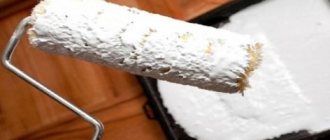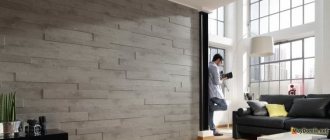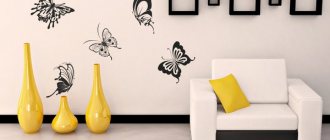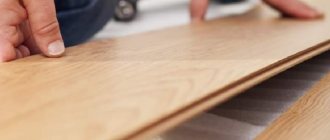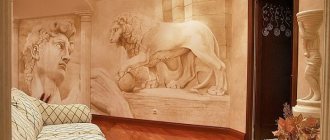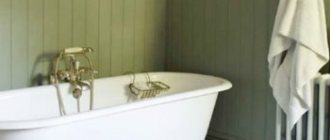The performance qualities of laminate and the wide choice of colors, textures and patterns, the relative ease of installation make us think about its possible use for wall decoration. Of course, first of all, this is a floor covering, popular and in demand, and not very often used as a wall covering. However, laminate can add interesting and fresh “notes” to the design of a room precisely when it is not used for its intended purpose. Which laminate to choose for installation on the wall and what are the specifics of such installation?
Arguments for"
At first glance, the idea of decorating a wall or niche with laminate looks unexpected. However, if you look at it, there are strong arguments in favor of such a decision:
- Great appearance. Some models of this coating are difficult to distinguish from natural valuable wood.
- Wear resistance, strength and long service life. The top protective layer perfectly protects the laminate from external influences.
- Antistatic.
- Simple installation that literally anyone can do.
- Easy care of laminate flooring during use.
- Affordable price for a material with such characteristics and appearance.
This coating has all the qualities to become part of the original and stylish design of the room, even if not in a very familiar role. Laminate on the floor and on the wall, selected in the same color scheme, will help visually expand the room.
Choosing a laminate for wall decoration
Important!
To decorate walls, you should choose a low-class coating (21-23) - it will experience virtually no stress. This way you can save a decent amount. It is important for you to choose a material that matches the color and pattern of your design ideas. However, it is quite difficult to buy low-class laminate; stores try not to keep it in stock. The choice of panel connection option (adhesive or locking) depends on the class of the laminate. Covering classes 21-23 are not available with a Click-lock; laminate of this class has only an adhesive connection. Laminate with an adhesive connection is mounted on a leveled surface, and the adhesive is applied in a zigzag pattern to the back side of the panel. Then glue is applied to the end of the panel and the next one is laid. Excess glue is immediately removed with a damp cloth, which is soaked in a weak solution of vinegar. A block is placed under the bottom panel as a stop so that the structure does not start to slide down.
Laminate flooring with Lock and Click locks is attached to the wall using liquid nails and clamps. Clamps are galvanized staples; they vary in size and shape. One type of clamp has teeth that are driven into the end of the panel and fixed with self-tapping screws or nails to the sheathing or wall, the other has a flat protrusion that fits into the groove of the panel. Clamps are specially designed for fastening lining, laminate and other similar coverings to walls, providing a very reliable fastening.
Advice from experts. The locking connection of panels with Lock and Click locks does not need to be coated with glue. But experts strongly advise using gel for laminate flooring - the gel will help maintain the elasticity of the connection.
Where and how will we use it?
Let's start with rooms where laminate flooring should not be laid on the walls. This is a kitchen, a bathroom, an uninsulated balcony, a basement in a country house. Changes in humidity and temperature will negatively affect the material, and it will quickly lose its appearance.
Traditionally, laminate is used to decorate walls in the hallway to the height of the panel. This coating is used to decorate part of the wall above the head of the bed in the bedroom, decorative panels are made from the laminate behind the TV in the living room, and niches are trimmed. The difference in shades of material in the same color scheme on the floor and on the wall creates an interesting effect.
How to decorate the walls of various rooms with laminate
The types of laminate finishes, its thickness and wear resistance allow you to choose an option for almost any room.
For the bathroom
A bathroom is a room with extreme conditions for any finishing material. In this room, the air temperature and humidity are constantly changing; water can get on any surface. But even for such conditions you can choose a laminate. It is better to give preference to a water-resistant rather than a moisture-resistant product. Waterproof laminate on the wall in the bathroom interior will last a long time and create a unique design for the room.
For kitchen
In the kitchen, all walls can be finished with laminate if the design of the room is made in eco-style or country style. Most often, laminate is used to finish one wall, next to which the work area is located. Or they decorate an apron over the work area. You can use regular laminated panels, or you can choose products with a special protective coating. It’s good if the laminate is combined with furniture and flooring.
For the living room
Using laminate on the wall in the living room interior is a successful interior solution that allows you to solve several problems at once:
- Firstly, decorative. Laminate flooring is selected in a warm shade for dark rooms whose windows face north. Thus, the room becomes cozier and warmer. For rooms with south-facing windows, choose light, cool colors. They balance the color palette, making the space lighter and cooler;
- Secondly, practical. If you cover a wall with a laminate on which a TV or home theater is located, then you can hide the wires between the covering and the wall;
- Thirdly, ease of care. It is easy to remove fingerprints, stains, splashes and other stains from the laminate. Therefore, it can be placed on a wall with living plants, the leaves of which are often sprayed.
For the bedroom
In the bedroom, finishing the walls with laminate is also relevant. Usually this is how the wall behind the head of the bed is decorated. Wall lamps or paintings are placed on this wall. If the bedroom is large and has an artificial fireplace, then the fireplace area can also be decorated with laminate.
Advice: it is better to match the laminate to the tone of the furniture. It can be laid in any convenient way - horizontal, vertical or diagonal.
For the corridor
Decorating the walls with laminate in the hallway is practical and beautiful. There are many people in the corridor every day - residents of the house or guests. The walls in this room often become dirty or scuffed. If you cover one wall in the corridor with laminate, or make laminated panels around the perimeter of the room, the problem of pollution will be solved.
Features of the installation process
Laminate is intended for laying on the floor, and the technology for installing it on walls, taking into account all the features of this material, has not yet been fully developed. Only recently have some manufacturers begun to produce special frames for attaching this coating to the wall.
One group of specialists refers to extensive practical experience and in videos posted on the Internet demonstrates fastening with liquid nails, clamps, and even self-tapping screws and nails. Some manufacturers (for example, Egger) show in video instructions that the first panel from the bottom is fastened with self-tapping screws at the bottom, and nails are hammered in the upper part (this is how the lining is attached).
Another group of specialists claims, and claims with good reason, that the coating cannot be fixed rigidly, which is why it is called a “floating floor.” A twisted screw or a hammered nail is not very compatible with the concept of a “floating floor”.
The truth, as usual, is somewhere in the middle. There is no point in refusing to use laminate as a material for decorating walls based on the theoretically correct judgments of the second group of specialists. But these judgments cannot be completely ignored either.
Important! During installation, try to avoid rigid fixation of the panels. How to do it? For example, the top panel in the structure is rigidly fixed to a metal sheathing using clamps. Next, the panels are secured with clamps with a flat protrusion, but the clamps themselves are not screwed to the vertical rail. Fixation is carried out only on panels of the 6-7th row, which gives some mobility to this part of the structure.
With the adhesive method of fastening, the wall surface must be dry and very smooth. You cannot attach the material to drywall that is simply glued to the wall - the entire structure will collapse under the weight. It should be remembered that laminate is a fairly heavy material.
For fastening to the sheathing, the pitch of the bars should not exceed 600 mm. For vertical installation of laminate, the sheathing bars are positioned horizontally, and for horizontal installation, the bars are mounted vertically.
A distance of about 10 mm should be left between the laminate structure on the wall and the walls in the room. The same distance should be between the structure and the floor. To maintain this distance, plastic wedges are used.
When laying laminate on a wall horizontally, it is necessary to maintain a checkerboard pattern or offset the next row by one third of the panel. Everything is the same as when laying it on the floor. With one long vertical seam, the load on the fastener increases. It is more convenient to start installation from the left corner of the wall and move to the right. However, it is more convenient for “right-handers” to work this way; it is more convenient for “left-handers” to start from the right corner.
Pros and cons of using laminate for finishing a balcony
To use laminate in finishing a balcony, one main condition must be met - it must be glazed. The fact is that this material is afraid of moisture and cannot get wet. The main advantages of its use include:
- Impeccable aesthetic qualities and a rich variety of textures and colors. If installed correctly, laminate flooring on a balcony will be impossible to distinguish from real parquet;
- Resistant to fading when exposed to ultraviolet rays;
- Easy installation on the balcony. Laying laminate flooring does not require special skills. It is a pleasure to work with thanks to the special tongue-and-groove connection;
- Laminate is resistant to fungi, mold and the development of various other microorganisms on it;
- Affordable price. The cost of laminate flooring for a balcony is relatively low, along with other facing materials.
- Easy replacement of one element. Unlike linoleum, the laminate does not have to be replaced entirely in cases of local damage;
- Wear resistance. With proper use, laminate flooring will last up to 10-15 years.
With such advantages, laminate flooring is still not without its drawbacks. Minuses:
- Deformation due to moisture. Cellulose, which is part of this material, when wet, tends to swell and deform the joints of the laminate. The protective film, of course, protects it from moisture, but only with short-term exposure;
- Response to temperature changes. Laminate expands at high temperatures and contracts at low temperatures. This must be taken into account when performing installation work. If the temperature on the balcony is unstable all year round, you should leave a small gap between the boards and the perimeter;
- High demands on surface quality. Laminate requires a flat surface and the smoother its surface, the more ideal the coating will be.
